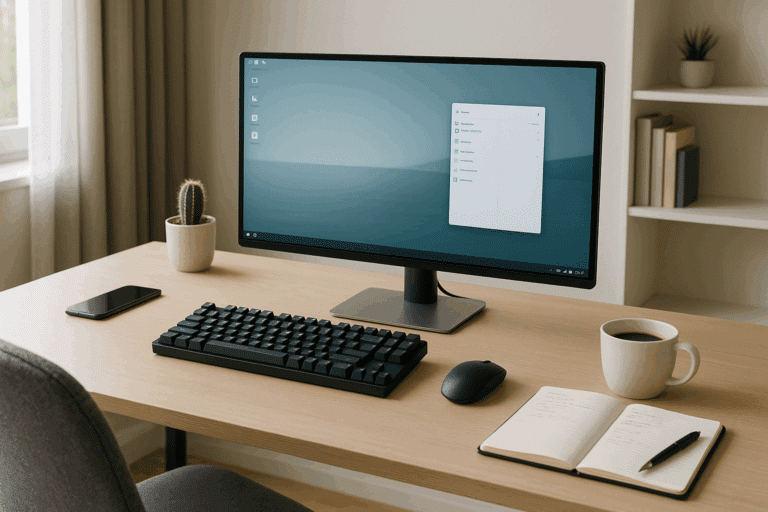In the world where the mantra “time is money” rings truer than ever, our ability to manage and prioritize tasks efficiently is a vital determinant of our productivity. It is no surprise then, that in the quest for maximal productivity, task management apps have emerged as a powerful tool in the arsenal of modern professionals. 🔧📲
Despite the apparent simplicity of the concept, the world of task management apps is as varied as it is vast. Ranging from minimalist to-do lists to complex project management software, these apps are designed to cater to a diverse array of needs. However, the very abundance of options available can sometimes make the process of selecting the right tool seem daunting. 😱
So, how do you navigate through the labyrinth of task management apps to identify the one that best suits your needs? How can you unleash the full potential of these apps to achieve maximal productivity? 🚀
These are the questions this comprehensive guide aims to answer. It will demystify the complex world of task management apps, helping you understand their functionality, evaluate their features, and choose the right tool to boost your productivity. 📈
🔍 Understanding Task Management Apps
In the first section of this guide, we will delve into the basics of task management apps. We will discuss what they are, why they are essential, and how they can help increase your productivity. We will also cover some key terms and concepts that will provide a solid foundation for the rest of the guide.
🔧 Exploring Features and Functionality
Moving on, we will explore the various features and functionalities that task management apps offer. We will categorize these features based on their function, such as task scheduling, collaboration, and reporting, and discuss how each can contribute to your productivity.
📱 Task Management Apps in Practice
In the third section, we will delve into practical examples of task management apps in action. We will examine various scenarios in which these apps can be leveraged for maximum efficiency, discussing best practices and providing tips on how to customize these tools to best suit your needs.
🎯 Choosing the Right App
Finally, armed with an understanding of the task management apps landscape, we will discuss how to choose the right app for your specific needs. We will cover factors to consider, pitfalls to avoid, and provide a roadmap to guide you in your decision-making process.
Whether you’re a seasoned professional looking to enhance your productivity game or a newbie just dipping your toes into the world of task management apps, this guide is designed to provide valuable insights to help you unlock the full power of these tools. So let’s dive in and start the journey towards a more productive future. 🌟
Understanding Task Management Apps and Their Power
Productivity is the holy grail in the world of business and personal development. The ability to do more in less time is often the key to success. But how do you unlock this ability? The answer lies in task management apps. Designed to streamline your workflow and make your life easier, these digital tools are your secret weapon in the fight against wasted time. But, before we delve into the nitty-gritty, let’s first understand what a task management app is and what it can do for you.
Task management apps, simply put, are applications that help you manage your tasks more efficiently. They can be used to assign tasks, track progress, and even prioritize your workload. With a task management app, you can organize your tasks in a way that makes sense to you, helping you stay focused and productive. Whether you’re juggling multiple projects at work or balancing your personal and professional life, a task management app can help you stay on top of things.
Now that you’ve grasped the basic concept of task management apps, let’s move on to the real question: How can these apps help maximize your productivity? To answer this, we need to delve deeper into the features and benefits of these tools. But before that, here’s an interesting video that elaborates on the concept of task management: “Why You Need A Task Management System” by Simpletivity.
Maximizing Productivity with Task Management Apps: A Detailed Analysis
Task management apps work by breaking down your tasks into manageable parts, allowing you to focus on one thing at a time. This not only helps you avoid feeling overwhelmed but also ensures that you’re making steady progress. Whether it’s a complex project or a simple task, breaking it down into smaller, more manageable tasks makes it easier to tackle. It’s like the old adage goes, “The best way to eat an elephant is one bite at a time.”
Another way these apps boost productivity is by helping you prioritize your tasks. Not all tasks are created equal. Some are more important or urgent than others. By helping you prioritize your tasks, task management apps ensure that you’re focusing your energy on the tasks that matter most. This prevents you from wasting time on less important tasks and ensures that you’re making the most of your time and energy.
Furthermore, task management apps come with a variety of features that can help streamline your workflow. From setting reminders and due dates to assigning tasks and tracking progress, these apps make it easy to manage your tasks. Plus, most of these apps come with a user-friendly interface, making them easy to use even for those who aren’t tech-savvy.
Comparing Top Task Management Apps
With so many task management apps out there, choosing the right one can be a daunting task. To make things easier for you, we’ve put together a comparison table of some of the top task management apps in the market.
| App Name | Key Features | Pricing |
| Todoist | Task assignments, Prioritizing tasks, Setting reminders | Free version available, Premium starts at $3/month |
| Asana | Project management, Timeline view, Collaborative tools | Free version available, Premium starts at $10.99/user/month |
| Trello | Board view, List-making, Integrations with other apps | Free version available, Premium starts at $9.99/user/month |
| Microsoft To Do | Integration with Microsoft apps, Task assignments, Setting reminders | Free |
For a more in-depth look at these apps and how to use them effectively, check out this video: “Top 10 Best To Do List Apps to Simplify Your Task Management in 2020” by Keep Productive.
Unlocking the Power of Task Management Apps: Tips and Tricks
Now that you understand the potential of task management apps, let’s delve into some tips and tricks to unlock their full power. First and foremost, it’s important to remember that these apps are just tools. They can help you manage your tasks more efficiently, but it’s up to you to use them effectively. Here are some tips to get the most out of your task management app:
- Start by listing down all your tasks. It’s hard to manage your tasks if you don’t know what they are. Start by making a list of all the tasks you need to accomplish. This will give you a clear picture of your workload and help you plan your day more effectively.
- Prioritize your tasks. Once you have your list, prioritize your tasks based on their importance and urgency. This will help you focus on the tasks that matter most, ensuring that you’re making the most of your time and energy.
- Use the features. Task management apps come with a variety of features designed to make your life easier. Make sure you’re using these features to their full potential. From setting reminders and due dates to assigning tasks and tracking progress, these features can make managing your tasks a breeze.
- Stay consistent. Consistency is key when it comes to task management. Make sure you’re using your task management app regularly. This will help you stay on top of your tasks and ensure that you’re making steady progress.
To sum it up, task management apps are powerful tools that can help maximize your productivity. Whether you’re a busy professional juggling multiple projects or a student trying to balance schoolwork and personal life, these apps can make your life easier and more organized. So, why wait? Start using a task management app today and see the difference it makes in your productivity! Remember, the key to unlocking the full power of these apps lies in using them effectively. So, use the tips and tricks we’ve shared in this article to get the most out of your task management app.

Conclusion
In conclusion, we have explored the complexities of software engineering and IT, delving into its numerous concepts, applications, and the evolving trends shaping its landscape. Our in-depth analysis has spanned from the foundational principles of software development, software testing, and design, to the advanced facets of machine learning, artificial intelligence, and cloud computing. This article’s purpose was to clarify the intricate details of these technical fields, demystifying jargon and elucidating complex processes that lie at the heart of our digital world.
Throughout this journey, we have underscored the power and significance of software engineering and IT. Not only do these fields drive our modern economies, but they also serve as a catalyst for innovation and progress, transforming businesses, industries, and our everyday lives. The digital revolution, spurred by the proliferation of software solutions and IT services, has redefined our world, opening up a plethora of opportunities and challenges alike.
Hence, understanding these technical domains is not only relevant for specialists, developers, or IT professionals. It is crucial for anyone living in our digital age. It equips you with the knowledge and skills to navigate the dynamic digital environment, enhance your professional prospects, and contributes to shaping a digitally inclusive society.
But this journey does not end here. The world of software engineering and IT is dynamic and continually evolving, with emerging trends, technologies, and methodologies reshaping its terrain. So, it’s crucial to stay abreast with these changes, constantly learning, and evolving with the times.
I hope this article has been a helpful guide, shedding light on the intricacies of software engineering and IT. But, your insights, thoughts, and experiences are equally important. So, I encourage you to share your perspectives in the comments below. Your engagement will not only enhance this discourse but also foster a vibrant and knowledgeable community.
Don’t forget to share this article with your colleagues, friends, or anyone who might find this information useful. And, of course, feel free to apply the knowledge and insights gained here in your professional or personal endeavors.
Lastly, if you’re eager to further your understanding, here are some valuable resources you might find useful:
1. [Software Engineering: A Practitioner’s Approach](https://www.amazon.com/Software-Engineering-Practitioners-Roger-Pressman/dp/0073375977) by Roger S. Pressman. It is a classic reference book that comprehensively covers the breadth and depth of software engineering.
2. [Software Testing and Analysis: Process, Principles, and Techniques](https://www.amazon.com/Software-Testing-Analysis-Process-Principles/dp/0471455938) by Mauro Pezze and Michal Young. A great resource for understanding software testing methodologies.
3. [Cloud Computing Bible](https://www.amazon.com/Cloud-Computing-Bible-Barrie-Sosinsky/dp/0470903562) by Barrie Sosinsky. This book gives a detailed understanding of cloud computing and its applications.
4. [MIT OpenCourseWare](https://ocw.mit.edu/courses/electrical-engineering-and-computer-science/) – A repository of free courses on various aspects of software engineering and IT.
5. [Codecademy](https://www.codecademy.com/) – An online platform offering interactive coding lessons.
In the words of Bjarne Stroustrup, the creator of C++, “Our civilization runs on software.” Thus, in this rapidly digitalizing world, the power of understanding software engineering and IT is immense. Let’s harness it together, learn, evolve, and shape a better digital future.
👍😀😊
References:
[1] Pressman, R.S., (2010). Software Engineering: A Practitioner’s Approach. 7th Edition. McGraw-Hill.
[2] Pezze, M. & Young, M. (2008). Software Testing and Analysis: Process, Principles, and Techniques. John Wiley & Sons.
[3] Sosinsky, B. (2011). Cloud Computing Bible. Wiley.



